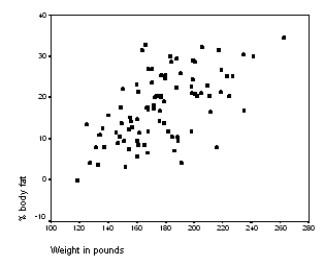Short Answer
The following scatter plot and SPSS output represent data collected on 89 middle-aged people.The relationship between body weight and percent body fat is to be studied. 



 What is an approximate 95% confidence interval for the average percent of body fat for middle-aged people who weigh 180 pounds?
What is an approximate 95% confidence interval for the average percent of body fat for middle-aged people who weigh 180 pounds?
Correct Answer:

Verified
Correct Answer:
Verified
Q31: A random sample of 79 companies from
Q32: A recent study was done to assess
Q33: A recent study was done to assess
Q34: The data referred to in this question
Q35: A random sample of 79 companies from
Q37: The data referred to in this question
Q38: A study was conducted to monitor the
Q39: The following scatter plot and SPSS output
Q40: The statistical model for simple linear regression
Q41: Suppose we are given the following information: